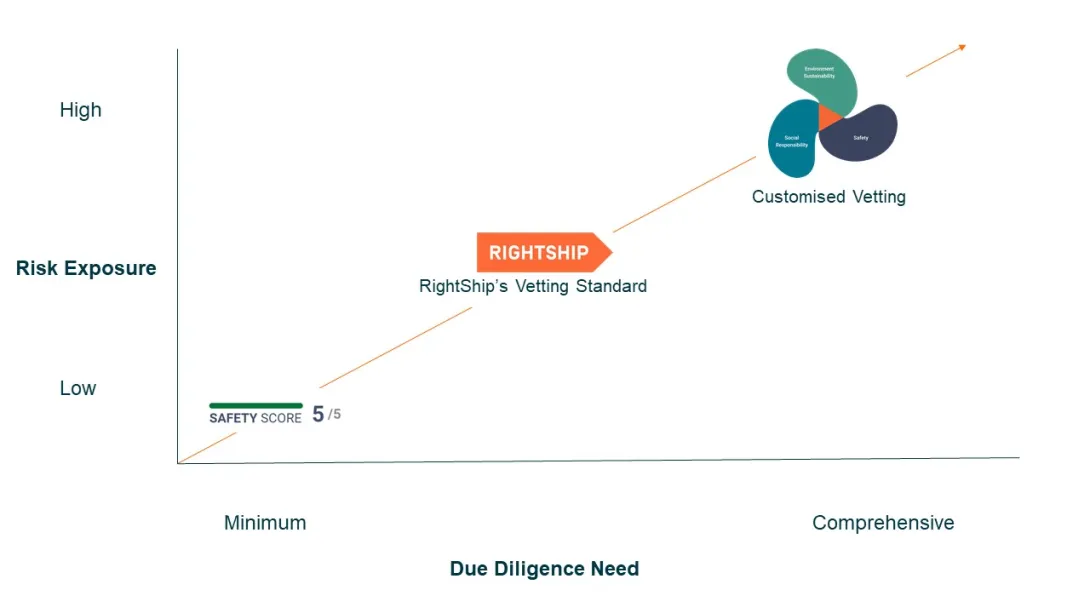How RightShip’s safety ecosystem helps to minimise risk exposure during vessel selection

RightShip’s safety ecosystem
We’re committed to ensuring our customers have a full view of their risk profile during the due diligence process, and we provide several safety products designed to minimise your exposure to incidents.
We offer a sliding scale of risk assessment tools, which deliver flexibility in terms of how comprehensive you’d like your vessel considerations to be.
Firstly, the Safety Score provides an initial look at a vessel’s suitability for charter. We allow you to add lenses, which you apply by looking at a vessel’s sub scores, activity data, valid RightShip Dry Bulk Inspection, verified GHG Rating, additional energy saving equipment – which give you a better picture of what is happening onboard the vessel – how it is managed, its condition and environmental footprint. This is an initial indicator in the process of selecting a vessel to vet.
Vessel vetting goes a step further and represents RightShip’s due diligence service, where all the above and more is considered, to help manage your risk exposure. It provides an outsourced and time-stamped profile, giving you a clear understanding of the measures taken to avoid a future accident, rather than simply highlighting the luck of not having had an accident in its operational history.
Your risk exposure levels
When considering which of our services are right for your needs, you must establish how much risk you are prepared to take on. For example, customers who only use the Safety Score (which reviews the operational history of a vessel) to perform simple risk assessment will be comfortable managing high risk themselves. At the Safety Score level, you receive a minimum crew welfare check, and the vessel’s environmental profile is not considered.
As you add further checks and assessments through services such as our dry bulk inspections and the GHG Rating, you are further able to manage your risk by looking at the historical data and current status of the vessel, allowing a greater degree of comfort for our customers who are prioritising their risk mitigation.
To support your due diligence process and to manage your risk, we recommend vessel vetting, which provides you with a recommendation for a future voyage. Vetting gives you comprehensive incident data, close out details, fleet ownership structure, sanctions and our expert’s recommendation of the suitability of a vessel for your next voyage.
In addition, RightShip’s vessel vetting provides peace of mind as an outsourced and time stamped due diligence process.
https://rightship.com/media/rwol1up1/charterers-graph.jpg
Moving from risk assessment to due diligence
In some cases, a vessel with a Safety Score of one will receive an “acceptable” vessel vetting recommendation, due to the trading routes of those vessels as they operate short haul, in low risk areas and have satisfactorily closed out an incident that happened recently.
Therefore, for charterers and those with cargo interests, we do not provide binary suggestions that it is acceptable to use a vessel with a Safety Score of three or more, because each journey, vessel, cargo type and terminal is different. Which is why we suggest removing RightShip’s Risk Rating or Safety Score from your charter party agreements. This is because a single score is not enough to tell you if a vessel is “good”, especially when considering all the variables of a voyage.
Instead we ask our customers to consider the level of information and inputs they require to make a vessel selection. To fully understand a vessel’s risk and safety profile using data from across RightShip’s entire safety ecosystem; and to truly manage the risk of a voyage, we recommend a vet. Every vet is unique and can only be used for the voyage under consideration.
That’s why we’re providing more transparency to our Safety Score, data within the platform, sustainability products and inspection results to help you choose vessels with the best operational performance and conditions, which measure up to the RightShip vetting standard.
What do I need to do before the Safety Score goes live in September?
As a charterer, if you currently have vessels on long-term charter and are concerned about their Safety Score, we recommend the following action:
- Get the vessel vetted
- Ask for the vessel to be inspected
Only with a vet in place can you be certain that your chartering decisions support your ESG and CSR objectives.